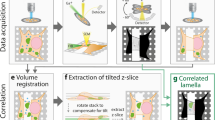Summary
In thin sections of the lung of the fresh-water turtle Pseudemys (Chrysemys) scripta some pneumocytes can be distinguished from the remaining pulmonary epithelial cells by a larger amount of mitochondria. In these cells the typical features of type-I and type-II cells are absent. Freeze-fracture replicas reveal rod-shaped particles in the apical plasma membrane of a small population of pneumocytes, which by cytological criteria seem to be identical with the mitochondria-rich cells observed in thin sections. It is assumed that these cells represent a distinct type of pneumocytes in the turtle lung and that they are a member of the group of mitochondria-rich cells present in some ion-transporting epithelia. The function of these cells in this location remains to be determined.
Similar content being viewed by others
References
Bargmann W, Welsch U (1972) Über Kanälchenzellen und dunkle Zellen im Nephron von Anuren. Z Zellforsch 134:193–204
Bargmann W, Knoop A, Schiebler TH (1955) Histologische cytochemische und elektronenmikroskopische Untersuchungen am Nephron (mit Berücksichtigung der Mitochondrien). Z Zellforsch 42:386–422
Brown D (1978) Freeze-fracture of Xenopus laevis kidney: rodshaped particles in the canalicular membrane of the collecting tubule flask cell. J Ultrastruct Res 63:35–40
Brown D, Montesano R (1980) Membrane specialization in the rat epididymis. I. Rod-shaped intramembrane particles in the apical (mitochondria-rich) cell. J Cell Sci 45:187–198
Brown D, Ilic V, Orci L (1978) Rod-shaped particles in the plasma membrane of the mitochondria-rich cell of amphibian epidermis. Anat Rec 192:269–276
Brown D, Grosso A, De Sousa RC (1981) The amphibian epidermis: distribution of mitochondria-rich cells and the effect of oxytocin. J Cell Sci 52:197–213
Brown D, Roth J, Kumpulainen T, Orci L (1982) Ultrastructural immunocytochemical localization of carbonic anhydrase. Histochemistry 75:209–213
Cohen JP, Hoffer AP, Rosen S (1976) Carbonic anhydrase localization in the epididymis and testis of the rat: histochemical and biochemical analysis. Biol Reprod 14:339–346
Eldrup E, Møllgard K, Bindslev N (1979) Possible sodium channels in the luminal membrane of the hen lower intestine visualized by freeze fracture. In: Bourguet J, Chevalier J, Parisi M, Ripoche P (eds) Controle hormonal des transports epitheliaux. INSERM, Paris, vol. 85, p 253–262
Eldrup E, Møllgard K, Bindslev N (1980) Possible epithelial sodium channels visualized by freeze-fracture. Biochim Biophys Acta 596:152–157
Fain W, Rosen S (1973) Carbonic anhydrase activity in amphibian and reptilian lung: a histochemical and biochemical analysis. Histochem J 5:519–528
Farquhar MF, Palade GE (1965) Cell junctions in amphibian skin. J Cell Biol 26:269–291
Frazier LW (1978) Cellular changes in the toad urinary bladder in response to metabolic acidosis. J Membr Biol 40:165–177
Hörandner H, Kerjaschki D, Stockinger L (1974) Rodshaped particles in epithelial free surface membranes. Eighth International Congress on Electron Microscopy, Canberra, vol. II, pp 210–211
Humbert F, Pricam C, Perrelet A, Orci L (1975) Specific plasma membrane differentiations in the cells of the kidney collecting tubule. J Ultrastruct Res 52:13–20
Husted RF, Mueller AL, Kessel RG, Steinmetz PR (1981) Surface characteristics of carbonic-anhydrase-rich cells in turtle urinary bladder. Kidney Int 19:491–502
Jonas L (1981) Histochemischer Nachweis von Carboanhydrase in den Flaschenzellen der Nieren vom Krallenfrosch (Xenopus laevis Daudin). Acta Histochem 68:238–247
Kerjaschki D, Hörandner H (1976) The development of mouse olfactory vesicles and their cell contacts: a freeze-etching study. J Ultrastruct Res 54:420–444
Lönnerholm G (1980) Carbonic anhydrase in the lung. Acta Physiol Scand 108:197–199
Lönnerholm G (1982) Pulmonary carbonic anhydrase in the human, monkey, and rat. J Appl Physiol 52:352–356
Menco BPM (1980) Qualitative and quantitative freeze-fracture studies on olfactory and nasal respiratory epithelial surfaces of frog, ox, rat, and dog. II. Cell apices, cilia, and microvilli. Cell Tissue Res 211:5–29
Miragall F, Breipohl W, Mendoza AS (1981) Morphological investigations on the rat vomeronasal organ. Verh Anat Ges 75:967–968
Miragall F, Breipohl W, Naguro T, Voss-Wermbter G (1984) Freeze-fracture study of the plasma membranes of the septal olfactory organ of Masera J Neurocytol, in press
Nielson DW, Goerke J, Clements JA (1981) Alveolar subphase pH in the lungs of anesthetized rabbits. Proc Natl Acad Sci USA 78:7119–7123
Orci L, Humbert F, Amherdt M, Grosso A, De Sousa RC, Perrelet A (1975) Patterns of membrane organization in toad bladder epithelium: a freeze-fracture study. Experientia 31:1335–1338
Rhodin J (1958) Anatomy of kidney tubules. Int Rev Cytol 7:485–534
Rosen S, Friedley NJ (1973) Carbonic anhydrase activity in Rana pipiens skin: biochemical and histochemical analysis. Histochemistry 36:1–4
Rosen S, Oliver JA, Steinmetz PR (1974) Urinary acidification and carbonic anhydrase distribution in bladders of Dominican and Colombian toads. J Membr Biol 15:193–205
Sapirstein VS, Scott WN (1975) Binding of aldosterone by mitochondria-rich cells of the toad urinary bladder. Nature 257:241–243
Stetson DL, Wade JB, Giebisch G (1980) Morphologic alterations in the rat medullary collecting duct following potassium depletion. Kidney Int 17:45–46
Sugai N, Ito S (1980) Carbonic anhydrase, ultrastructural localization in the mouse gastric mucosa and improvements in the technique. J Histochem Cytochem 28:511–525
Sugai N, Ninomiya Y, Oosaki T (1981) Localization of carbonic anhydrase in the rat lung. Histochemistry 72:415–424
Voute CL, Meier W (1978) The mitochondria-rich cell of frog skin as hormone-sensitive “shunt-path”. J Membr Biol 40:151–165
Voute CL, Hänni S, Ammann E (1972) Aldosterone induced morphological changes in amphibian epithelia in vivo. J Steroid Biochem 3:161–165
Wade JB (1976) Membrane structural specialization of the toad urinary bladder revealed by the freeze-fracture technique. II. The mitochondria-rich cell. J Membr Biol 29:111–126
Welsch U, Müller W (1980) Feinstrukturelle Beobachtungen am Alveolarepithel von Reptilien unterschiedlicher Lebensweise. Z mikrosk-anat Forsch, Leipzig 94:479–503
Author information
Authors and Affiliations
Rights and permissions
About this article
Cite this article
Bartels, H., Welsch, U. Freeze-fracture study of the turtle lung. Cell Tissue Res. 236, 453–457 (1984). https://doi.org/10.1007/BF00214249
Accepted:
Issue Date:
DOI: https://doi.org/10.1007/BF00214249




